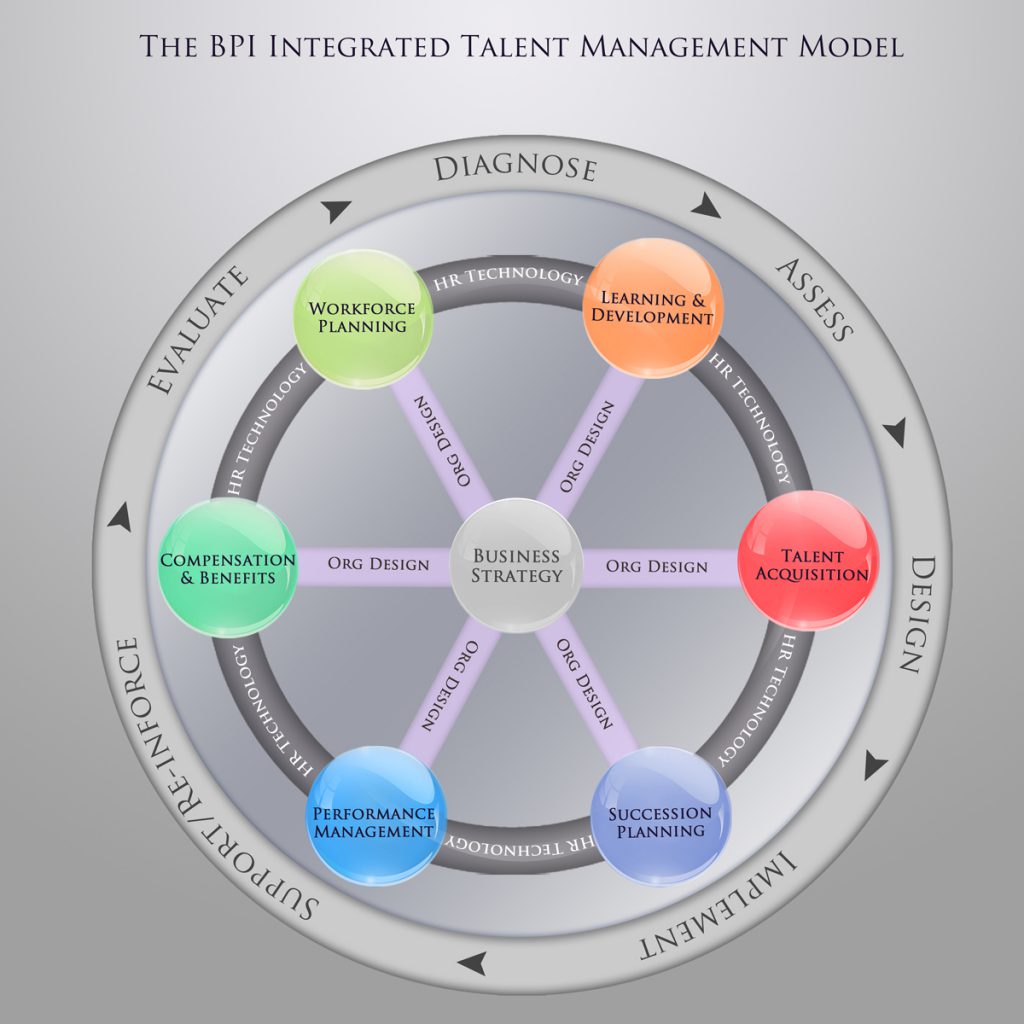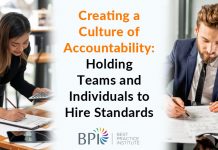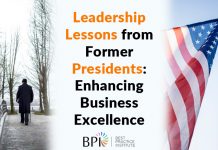ITM means aligning your talent functions to the organization’s greater goals. Modern corporations that are succeeding in integrating their talent management systems are beating the competition in recruiting the best talent, getting the most out of the talent they have, and preparing today’s talent for tomorrow’s challenges.
The talent management systems process at most companies includes workforce planning, talent acquisition, learning and development, performance management, succession planning, and compensation and benefits.
Each piece of this puzzle affects other talent management systems. For example, workforce planning should be a major driver of talent acquisition, and learning and development should focus on needs identified in succession planning. Integrated talent management (ITM) seeks to connect these various talent activities into a seamless, synchronous whole.
What it is
ITM is achieved when some or all talent management systems of an organization support each other and share talent data, forming a holistic approach to talent management that is aligned to the organization’s corporate strategy.
In some companies, recruitment amounts to little more than filling vacancies with warm bodies or, even worse, hiring the people the company needed 10 years ago to meet the needs the company will face 10 years from now. A much more productive approach is to make sure corporate strategy is driving every talent decision. Achieving this requires an integrated organization.
The ITM model developed by Best Practice Institute graphically represents these principles in the form of a wheel. This model has been validated by the BPI Senior Executive Board. The hub is business strategy. The spokes connect each talent management function to the strategy. And the rim is the HR/ITM technology linking the many talent functions and making shared data possible.

What does ITM look like at a corporation that has achieved it? Here are the two essential qualities.
All talent management systems and functions are aligned with and driven by corporate strategy.Before integration, business unit leaders made talent decisions based on that unit’s needs, with little consideration of the organization’s greater strategy and goals. That remains the present reality at many organizations.
Meetings, memos, and walking around are insufficient ways for senior executives to promote strategy. What really makes the difference is driving strategy through talent decisions. Who are we hiring? Who are we promoting? How are people being assigned, assessed, and rewarded? The answers should all be tied directly to corporate strategy.
All talent management functions and data are linked through robust ITM technology.Many companies have a startling lack of knowledge of their own team members. Before a talent executive’s company underwent sweeping changes in how it does talent, he confided that LinkedIn knew more about its employees than the company did.
Many other corporations collect a wealth of personnel data, but those data are held hostage by the incompatible technologies of various business units and departments.
Guidelines
Here are five steps to lead your organization into the 21st century through Integrated Talent Systems Management
Leadership. Select a team to champion the integration. Harmonizing talent management systems across multiple business units requires leaders with authority, diplomacy, and technical savviness. The team should include someone from the C-suite, and will likely be driven by someone from HR.
At CDW Corporation, integration was led jointly by the company’s senior director of talent acquisition and its senior director of organizational capability. At E.W. Scripps, it was led by the HR director and the vice president of talent management. A successful ITM team will be cross-functional, be composed of genuine change agents, and have full support from the top.
Diagnosis. There are many great reasons to integrate talent management, but it is essential to know the particular rationale why your company needs Integrated Talent Management Systems and what it expects Integrated Talent Management Systems to accomplish. Meaningful conversations with key leaders across the organization are a critical part of forming the diagnosis.
Technology. One reason diagnosis is important is because it guides your selection of Integrated Talent Management systems software. Will the solution you choose deliver in the areas your company especially needs it to?
CDW used a questionnaire to identify critical features of the desired Integrated Talent Management systems software; the responses became a list of criteria the company used in comparing products and suppliers. Destination Hotels & Resorts identified three supplier “finalists,” and then asked to interview customers of each.
Many companies choose to develop their Integrated Talent Management systems technology in-house. In 2012, Best Practice Institute surveyed eight large corporations that had attempted to achieveIntegrated Talent Management systems. About one-third of those are using internally developed Integrated Talent Management systems.
Buy-in. The previous steps are all crucial to achieving buy-in. Training and communication also can help with the reception during rollout. Destination Hotels pulled out all the stops to spread the word about its new Integrated Talent Management systems technology, including classroom sessions, webinars, memos, and internal web portals.
Implementation and evaluation. Integrating talent management does not happen overnight. It is a continuous process of keeping talent activities connected to corporate strategy and to each other.
Successful implementation includes systematic evaluation. Are your Integrated Talent Management systems producing the desired results? Microsoft, CDW, and Amway all use employee surveys to evaluate their Integrated Talent Management system success.
Results
In a survey conducted by Best Practice Institute, companies with successful Integrated Talent Management systems processes reported these benefits:
- improved use of existing talent through such Integrated Talent Management-facilitated methods as talent referral programs and cross-functional moves
- improved employee engagement; Microsoft’s employee attitude surveys revealed a more positive outlook after implementing Integrated Talent Management
- improved succession planning
- better employee retention.
Becton Dickinson-Japan, a medical equipment company that was an Integrated Talent Management pioneer in the mid-2000s, reports that it has experienced a 130 percent increase in revenue since integrating its talent functions.
It is no surprise that when a company’s corporate strategy is driving its talent decisions, and its various talent functions are supporting each other harmoniously, productivity can skyrocket.










